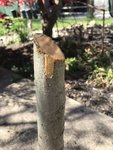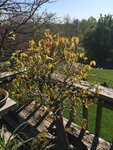Hi, I think I can help with your tree, hornbeams are one of my favorite species and I’ve collected many. They are easy to work with. I’ll show you some pics of a tree that was very similar to yours that I collected 5 years ago. I can tell from your roots that this tree was growing on a slight slope, as was mine. If you plant it vertically in a pot, then you have the roots on one side sticking up. I opted to go with this and have a tree with a lean.
First your potting mix, I use 60% turface, 40% composted pine bark fines, not big chips. I have used this for years and it works extremely well for collected deciduous trees. If your tree has only been planted a day or two it won’t hurt it a bit to start over. No roots have grown yet. you can get turface at John Deere wholesale garden centers. Bout $10.00 for a 50 pound bag, enough to do dozens of trees. I’d source this if you can.
Now for your roots, most all of your new roots will form at the ends of the large roots, where they will callous over. Fine roots really matter very little on collected stumps like this. what you want to do is figure out your planting angle now and size of pot you would want to use in the future and mentally cut your roots to fit now. Cut so the tree can sit flat on a table at the depth you envision in the future. Angle the cut ends like 45 degrees. Some will say slowly reduce roots over time, but that is crazy. This tree doesn’t care if that root you left is 12 inches long or 3. It is just going to grow new roots at the cut ends. If you have to reduce later, you will just be cutting off all the progress you have made and starting over. so trim to final lengths now, it won’t hurt the tree.
The top, these trees will throw a lot of new buds from the trunk, but you never know exactly where. Best to just let it do it’s thing and you can pick the new leader in a year or two and trim the trunk to final length then. The important thing is to seal the copped trunk so the tree doesn’t loose lots of water through the chop. Get a spray can of, usually black, tree wound sealant. most garden centers have this. You can hold the tree upside down and thoroughly coat the chop. It dries in seconds and this way it doesn’t run down all over your tree, will wear away in a year or two. Much cheaper than cut paste. A can will last a very long time.
Your planter, I use the black plastic dish washing tubs at Walmart, bout three dollars each. These are about 18x18 inches and bout 8 inches deep. I’m concerned yours is too shallow. You want those cut ends of the roots to be well covered with your mix, so there is not any drying. If too close to the surface in summer new roots could dry and die. Remember these new roots are very fragile and will form at the cut ends of the large roots.
Finally, pick a spot that is east facing - morning sun and afternoon shade. And this is important, don’t be moving the tree around for the first couple years. If you do use one of those tubs, they flex quite a bit, this causes movement of the soil mix when moved, and this can damage/destroy the fine new roots. If your planter is rigid then this is not as much an issue. Then just keep your tree well watered. I don’t worry about fertilizing the first year. The tree really has to grow some roots first anyway to access the fertilizer, and the fine new roots can be burnt easily by fertilizer if you aren’t very careful. The second year you can start a fertilizing regimen.
By doing all this I think your tree will have an excellent chance. I don’t think I have ever lost a trunk chopped hornbeam, they are pretty tough. Remember to always collect deciduous trees while still dormant. If collected after they have leafed out a lot of the tree’s stored energy resources have gone into those new leaves you chopped off, and this reduces your chance of a successful collection. Best of luck with your tree, I hope this helps. Randy











